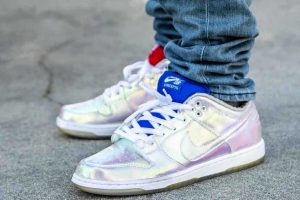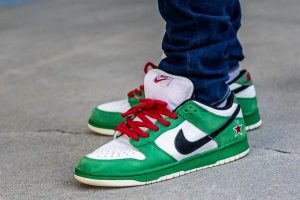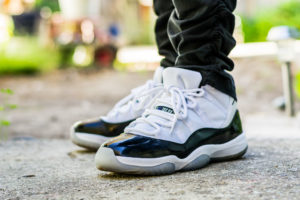The term “sneaker grail” gets thrown around a bit, often without context or definition. In fact, there are different ways to look at what constitutes a grail sneaker.
Holy Grail Sneaker Definitition
A grail is technically a very rare, almost impossible to attain sneaker. It is also used as a way to describe an individual’s most wanted and hardest to get sneaker.
“Grail” usually describes the most rare (and usually most expensive) sneakers available. However, it can also mean something different on a personal level. When used in everyday conversation, it refers to a specific person’s most wanted shoe.
This individualized categorization of a shoe is also relatively expensive and/or rare in it’s own right. The high barrier to acquisition is relative, but inherent in the claim.
For example, while Heineken SB Dunks aren’t the most rare sneakers, they are relatively hard to find and priced prohibitively high in the aftermarket. For me, these were a total grail and one of the last I made sure to attain back when I was chasing down grails.
What The Most Sought After Sneakers Are
Incredibly rare sneakers that go for high dollars in resale are usually the most coveted. This includes sneakers like the Nike SB Dunk Low Freddy Krueger and the Eminem Air Jordan 2.

The last grail I ever hunted down
and probably the most expensive
sneaker in my collection!
Buy Now: eBay
I’ve noticed that when googling “sneaker grails”, many articles simply go with the most expensive sneakers. Clearly, price is tied to a sneaker’s grail status.
I think rarity is the key component here, though. The high price is just a byproduct. Of course I’m speaking about the term “grail” in a broad sense here. What an individual collector views as expensive or hard to get will differ from person to person.
Even before it was all about resale prices, the sneaker game produced a number of hard to find kicks. Typically these are rare friends and family or Tier 0 releases. Extremely limited pairs like the Playstation Air Force 1s or Nike SB Dunk Low City Pack (London, Paris, etc) also fall in this category.
Grails can also be pairs that are scrapped after a limited run is produced. Sneakers like the Heinekens and Freddy Krueger SB Dunks were cancelled due to copyright or trademark issues, but some pairs still made it out there to the public.
A sneaker doesn’t need to be a grail to be among the most sought after. Technically, many commonly available kicks are very sought after. However, if the shoe is prohibitively expensive or rare, it moves into that grail status, whether on an individual level, or just in general.
The Holy Grail of Jordans
According to some sources including Nike, the Air Jordan 11 Concord is the holy grail of Air Jordan retros. This is interesting since there are multiple Concord 11 retros which decreases the rarity and aftermarket prices.
The fact that Nike would call the Concords the Holy Grail of Jordans illuminates how the term “sneaker grail” is actually a bit of a moving target.
One would think a more rare colorway would be at the forefront of what most consider a grail. While sneakers like the Undefeated Jordan 4 are certainly more rare, Nike calls the Concords a grail due to it’s iconic nature in the line.
Compared to the rarest kicks that go for thousands of dollars, the AJ11 Concord usually goes for less than $500 depending on size and which retro. And yes, there have been a few releases of the Concords.
On an individual level, there are many Jordan collectors that would agree with Nike. Not everyone wants Quai 54 5s or Eminem 2s, so even though they are rare and expensive, they might not make everyone’s grail lists. Shoes like the Concords are so iconic that many collectors view them as a “must have”. While $3-500 might not seem like a lot compared to more rare pairs, it’s a hefty amount to pay for a sneaker, objectively speaking. An iconic must have that’s relatively expensive for a shoe and only retros every several years makes these a grail for many.
Do Sneakerheads Need Grails
Sneaker collectors do not “need” grails in order to build up an enviable collection. However, the pursuit of grails comes with increasing one’s sneaker knowledge in general and can be useful as a way to give a collection direction.

A Concepts collab that actually plays
on the term “grail”
Buy Now: eBay
When I first started collecting, I would often pursue personal grails as a way to move my collection along. It felt like if I wasn’t going for that out-of-production pair that was just a bit more expensive than I could afford, I wasn’t building a real collection. Eventually, I had all my grails and now I can continue collecting without constantly having a big purchase waiting to happen.
I think grail hunting is a good way to learn more about kicks. The amount of research that goes into a just out of reach pair you’re obsessed with can teach you a lot of sneaker history.
The rarest kicks that go for crazy amounts of money are technically grails in a wider sense. However, for practicality’s sake, your own personal “eventual must-haves” will take you down a rabbit hole of sneaker collecting knowledge. Learning why a shoe is rare and/or expensive, the backstory behind the shoe, where it can be found and what it will do for your collection will immerse you in the world of sneakers.
If you’re like me, eventually you “catch up” to some degree. Out-of-circulation pairs wind up in your box stacks and you wind up with a highly individualized collection full of unique oddities. Sidenote – since even most common pairs eventually become not-so-common, even “bricks” in your collection can wind up as someone else’s grails.
Once this catch-up occurs, the concept of grails can fade. At least it did for me. While I recognize sneakers that others consider grails, I don’t personally have any pairs that I’m actively pursuing in this light. And when I see someone else proclaiming a shoe is their grail, I think “good luck and happy hunting”!


